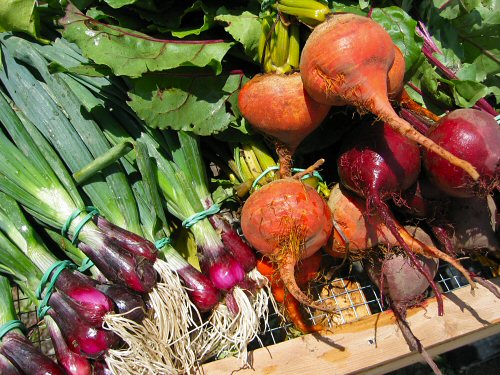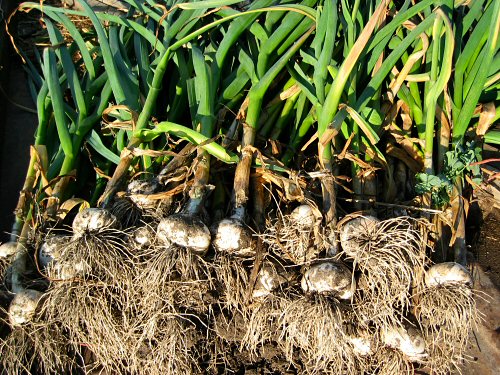
Veggie variety is great: different tastes, textures, shapes, colors… From the start, it seemed only natural to grow several varieties of each crop rather than just the most “efficient” one. This has worked out to at least a couple per crop (this year, two types of spinach so far, three potato, two corn…) to many (at the extreme end, 50+ varieties of tomato). The biggest difference is quite often in maturity date: crops fairly similar in taste and appearance can be two or three weeks or more apart in maturing for harvest. Sometimes the difference is only skin deep. The Red Baron spring onions in the pic are only red for a couple of layers, but they look great when you get ’em. The Golden Detroit beets taste a little different from red varieties, but the fun (for me, at least) is mainly in the striking and unusual golden-orange flesh. Look before you eat!




Besides tasting and looking great, one of the nice things about the golden beets is they don’t stain. I love beets, but one of the things I really hate is cleaning up all the red everywhere after I’m done eating and cooking.
Hey Patrick: Yes, that’s true as well! The red goes everywhere, even when quickly rinsing whole, just pulled beets. Of course, I do like the reds, the “classic” beet around here. :) Problem with the goldens is the seed around here is about 5 times as expensive as for even the more expensive hybrid varieties of red ones. I used to grow Burpee’s Golden, which was always expensive, then last year, one of my main seed houses introduced Golden Detroit at a “normal” price. This year, they kicked it up to the Burpee price. I should’ve stocked up then. Dunno why this is, I should check whether golden is an old style or a new breeding thing, I imagine it’s old… Oh, and I consistently find that the greens of both types of golden have a noticeably distinctive, IMO superior flavor, at least, when eaten raw, a kind of tart edge…
Saving your own seeds from beets is not very difficult. The first thing is to be as certain as possible you are starting with Open Pollinated (OP) seeds, maybe this is something you can confirm with your supplier. While Burpee Golden and Golden Detroit are the names of heirloom varieties and so should be OP, there are no guarantees that there aren’t non OP (or F1 hybrid) varieties also in use. If you don’t start with OP seeds, you won’t end up with useful seeds for planting when you are all done.
The next important thing is to only select the best plants to save seeds from. Dig up several, and look at the roots, maybe taste the greens, by every measure you can think of make sure you are only using the best possible plants.
Make sure you use enough plants for what you intend to use the seeds for. If you don’t have enough plants, the resulting seeds (possibly in future generations) will suffer from inbreeding depression. This basically means the plants will get weaker with each successive generation, and will eventually no longer be useful for planting. It’s always the case that the more plants the better, and also consider that some plants may die along the way so always think about having some extras.
If what you want to do is save seeds for a single generation of planting, for example if you just want to do a seed saving trial or want to alternate buying seeds one year with a year of saving and replanting, and you don’t ever want to try to save seeds from a second or third generation of plants, saving seeds from 6 plants is a reasonable number. If you want to save your seeds every year, and never want to have to buy more, the absolute minimum is probably 40, but 50-100 plants is probably a better number.
Of course you won’t have to save your seeds every year, because they should remain viable for 5 years or so, or longer if you freeze them. 6 plants will give you a lot of seed too!
Beets are biennials, so will flower and set seed in the second growing year. I’m guessing your climate is too harsh for leaving the beets in the ground for the winter, so you need to dig the plants up in the fall and bring them indoors. You should store them in damp sand or sawdust, and the ideal temp is about 32-40F (0-5C). They will keep for about 6 months like this.
Early in the summer they will flower, and you should make sure there are no plants they can cross pollinate with in an area of about 5 miles too be completely sure. If they do cross with something, it won’t be the end of the world, you will just end up with some unusable plants that will have to be discarded. Beets can cross with other beets and swiss chard.
What I’ve said here applies to beets. If you save seeds from other plants, it might be a little different.
If you go to the trouble of saving seeds from large numbers of plants of successive generations, you will probably end up with plants that are stronger and of higher quality than what you grow from the seed you use now. This is because it will genetically acclimate itself to your local growing conditions.